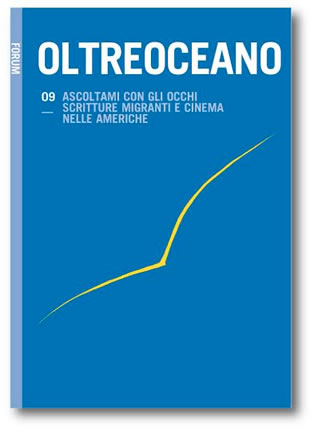“Danser entre les langues”: Antonio D’Alfonso tra cinema e letteratura
Keywords:
cinéma et littérature, écriture de migrants, Québec, 20ième siècle, intermédialitéAbstract
Andrea Schincariol studia la presenza del cinema nella trilogia di Antonio D’Alfonso dimostrando come il cinema, tema e dispositivo della rappresentazione, si lega alla questione centrale della poetica d’alfonsiana: la questione identitaria.
“Danser entre les langues”. Antonio D’Alfonso between Cinema and Literature
Andrea Schincariol studies the impact of cinema on Antonio D’Alfonso’s trilogy. He shows how cinema is a theme as well as a structural element of the three novels. He also analysis the relation between cinema and the most important theme of D’Alfonso’s works: the question of identity.
Downloads
References
Abadie, K. & Huglo, M.-P. (2014): Introduction. Textimage 6. Tiré de da http:// revue-textimage.com/10_cinesthetique/introduction1.html
Cléder, J. (2012): Entre littérature et cinéma. Les affinités électives. Paris: Armand Colin.
Compagnon, A. (1979): La Seconde main ou le travail de la citation. Paris: Seuil.
D’Alfonso, A. (1987): Poème #13. L’Autre rivage. Montréal: VLB.
D’Alfonso, A. (1990): Avril ou l’anti-passion. Outremont: VLB.
D’Alfonso, A. (1996): In Italics. In Defence of Ethnicity. Montréal: Guernica.
D’Alfonso, A. (1998): L’Amour panique. L’Apostrophe qui me scinde. Montréal: Noroît.
D’Alfonso, A. (2004): Un vendredi du mois d’août. Montréal: Leméac.
D’Alfonso, A. (2007): L’Aimé. Montréal: Leméac.
D’Alfonso, A. (2013): De l’insignifiance. Montréal: Point de fuite.
D’Alfonso, A. (1987): Filmografia. Tiré de http://antoniodalfonso.wix.com/antoniodalfonso#!films-awards
Derrida, J. (1967): De la grammatologie. Paris: Minuit.
Eco, U. (1983): Lector in fabula. La cooperazione interpretativa nei testi narrativi. Milano: Bompiani.
Everaert-Desmedt, N. (1990): Le Processus interprétatif. Introduction à la sémiotique de Ch.S. Peirce. Liège: Pierre Mardaga.
Ferraro, A. (2014): Écriture migrante et translinguisme au Québec. Venezia: La Toletta.
Genette, G. (1968): Vraisemblance et motivation. Communications, 1, pp. 5-21.
Gris, F. (2012): Images et imaginaires cinématographiques dans le récit français contemporain (de la fin des années 1970 à nos jours). Thèse de doctorat sous la direction de Jean-Bernard Vray. Université Jean Monnet.
Jakobson, R. (1985): Linguistica e poetica. In R. Jakobson, Saggi di linguistica generale (181-218). Luigi Heilmann (Ed.). Milano: Feltrinelli.
MacLennan, J H. (1945): Two Solitudes. Toronto: New York and Des Moines.
Marsolais, G. (1997): L’Aventure du cinéma direct revisitée: histoire, esthétique, méthodes, tendances, textes des cinéastes, repères chronologiques, glossaire, index. Montréal: Les 400 coups.
Ortel, P. (2008): Vers une poétique des dispositifs. In P. Ortel, Discours, image, dispositif. Penser la representation, II (pp. 33-58). Paris: L’Harmattan.
Raynauld, I. (1991): Le Lecteur/spectateur du scénario. Cinémas: revue d’études cinématographiques/Cinémas. Journal of Film Studies, 2, 1, pp. 27-41.
Santini, S. (2014): Cinéfiction. La performativité cinématographique de la littérature narrative. Textimage, 6. Recuperato da http://revue-textimage.com/10_cinesthetique/santini1.html. (Visitato l’1/10/ 2014).
Schincariol, A. (2014): Du cinéma au cinématographique. Étude de la trilogie de Fabrizio Notte d’Antonio D’Alfonso. Textimage, 6. Tiré de http://revue-textimage.com/10_cinesthetique/schincariol1.html
Silva Paranhos, A. L. (2011): La Trilogie en italique d’Antonio D’Alfonso: un parcours vers le texterhizomatique. Tese de Doutorado em Literaturas francesa e francófonas, Universidade Federaldo Rio Grande do Sul.
Vermetten, A. (2005): Un tropisme cinématographique. L’esthétique filmique dans Au-dessus du volcan, de Malcolm Lowry. Poétique, 144, pp. 491-508.
Downloads
Published
How to Cite
Issue
Section
License

This work is licensed under a Creative Commons Attribution-NonCommercial-ShareAlike 4.0 International License.
The authors undertake to comply with the following conditions, which are considered accepted at the time of submission of their contributions.
The sending of a text implies that it is unpublished and not submitted to be published elsewhere.
1. If accepted, the author shall confer on the publisher the right to publish and distribute it both in paper form and in the online electronic edition. The published articles will be downloadable and made available in open access.
2. Provided that it correctly indicates that the first publication took place in the journal Oltreoceano. Rivista sulle migrazioni the author has the right to: a) reproduce the article in separate extracts or collected in a volume; b) publish the article on their personal website or teaching site provided that these sites are of a non-commercial nature; c) deposit the article in online archives of a non-commercial nature, linked to the institution they belong to or as part of projects for the non-commercial dissemination and open access of scientific works.
The use of contributions by third parties, for commercial or otherwise unauthorized purposes, is not allowed. The publisher declines all responsibility for the unauthorized use of the material published in the journal.












